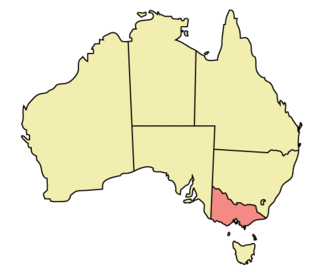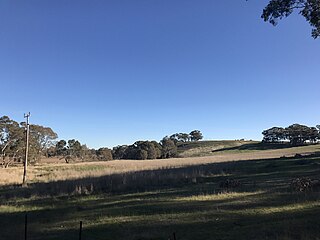
The Nightcap National Park is a national park situated within the Nightcap Range in the Northern Rivers region of New South Wales, Australia. The 8,080-hectare (20,000-acre) park was created in April 1983 and is situated 35 kilometres (22 mi) north of Lismore. The national park is classed by the IUCN World Commission on Protected Areas as Category II and is part of the Shield Volcano Group of the World Heritage Site Gondwana Rainforests of Australia inscribed in 1986 and added to the Australian National Heritage List in 2007.

A road verge is a strip of grass or plants, and sometimes also trees, located between a roadway (carriageway) and a sidewalk (pavement). Verges are known by dozens of other names, often quite regional; see Terminology below.
Ferny Creek is a suburb in Melbourne, Victoria, Australia, 33 km south-east of Melbourne's central business district. Its local government area is the Shire of Yarra Ranges. At the 2016 census, Ferny Creek had a population of 1,518.

Crib Point is a town in Metropolitan Melbourne on the Mornington Peninsula, Victoria, Australia. It is part of the urban enclave on Western Port comprising Bittern, Crib Point, Hastings, Tyabb, and Somerville. Its local government area is the Shire of Mornington Peninsula.

The Flora and Fauna Guarantee Act 1988, also known as the FFG Act, is an act of the Victorian Government designed to protect species, genetic material and habitats, to prevent extinction and allow maximum genetic diversity within the Australian state of Victorian for perpetuity. It was the first Australian legislation to deal with such issues. It enables the listing of threatened species and communities and threats to native species, and the declaration of critical habitat necessary for the survival of native plants and animals.

Tower Hill Wildlife Reserve, formerly Tower Hill State Game Reserve, is a protected area located in the Australian state of Victoria, approximately 275 kilometres (171 mi) west of Melbourne, and 15 kilometres (9.3 mi) north-west of Warrnambool. It encompasses the extinct Tower Hill volcano and wetland and is 614 hectares in area.

The Dryandra Woodland is a national park in Western Australia within the Shires of Cuballing, Williams and Wandering, about 164 kilometres south-east of Perth and 22 kilometres north-west of the town of Narrogin. It is a complex of 17 distinct blocks managed by the Western Australian Department of Parks and Wildlife and spread over approximately 50 kilometres separated by areas of agricultural land. The area is considered to be one of the state's major conservation areas, and although it is far from pristine due to its history of logging operations, a number of species of threatened fauna are rebuilding populations through the removal of introduced predators such as foxes and feral cats.

The Cathedral Range State Park is located in Victoria, Australia, approximately 100 kilometres (62 mi) north-east of [Melbourne]. It is situated between the towns of Buxton and Taggerty and runs parallel to the Maroondah Highway. The Cathedral Range was declared a State Park on 26 April 1979. It consists of 3,577 hectares and contains the rugged Razorback and spectacular peaks of the Cathedral Range, Little River and forested hills of the Blue Range. Due to its proximity to Melbourne the Cathedral Ranges are a popular destination for both day and weekend adventures. Bushwalking, camping, rock climbing and abseiling are some of the more popular activities available. Cathedral Range State Park is listed as Category II under the IUCN World Commission on Protected Areas and is an example of a park that can be used for recreation, education and conserving natural ecosystems.

The Threatened Species Protection Act 1995, is an act of the Parliament of Tasmania that provides the statute relating to conservation of flora and fauna. Its long title is An Act to provide for the protection and management of threatened native flora and fauna and to enable and promote the conservation of native flora and fauna. It received the royal assent on 14 November 1995.

Lewin's rail is a species of bird in the family Rallidae. It is found in Australia, Wallacea, and New Guinea. Lewin's rail is also known as the water rail, Lewin's water rail, Lewin's grind rail, slate-breasted rail, slate-breasted water rail, pectoral rail, pectoral water rail, short-toed rail and short-toed water rail. Its natural habitat is subtropical or tropical moist lowland forests.

Land clearing in Australia describes the removal of native vegetation and deforestation in Australia. Land clearing involves the removal of native vegetation and habitats, including the bulldozing of native bushlands, forests, savannah, woodlands and native grasslands and the draining of natural wetlands for replacement with agriculture, urban and other land uses.

Muckleford is a small regional area in central Victoria, Australia. The area, also known as Wattle Flat, lies along the Muckleford Creek, a minor tributary of the Loddon River, approximately 127 kilometres north-west of the Melbourne city centre, and within the jurisdiction of the Mount Alexander Shire council. The nearest sizeable town is Castlemaine, approximately 7 km to the east. The original township is named after the English hamlet of the same name in Dorset, UK.
Established in 1965, the Yellingbo Nature Conservation Reserve is located 45 km east of Melbourne in the Upper Yarra Valley, near the towns of Yellingbo, Launching Place, Yarra Junction, Hoddles Creek, Cockatoo, Emerald, Monbulk and Seville. Yellingbo Nature Conservation Reserve is a narrow riparian reserve with stream-frontage land along the Woori Yallock, Shepherd, Cockatoo, Macclesfield and Sheep Station Creeks.
Biolink zones are a land use category developed for biodiversity conservation and landscape adaptation under changing climates. Biolink zone was first coined in 1992 to encapsulate a potential new land-use resulting from research on vertebrate fauna of se Australia and their prospective responses to climate change. Biolink zones are identified parts of the landscape where the functional ecological connectivity for biodiversity is enhanced and / or restored to provide space for species to self adapt their distributions and abundances under changing climates through natural processes including: dispersal; re-colonisation; regeneration and restoration of ecological function.

Gahnia grandis is a tussock-forming perennial plant found in southeastern mainland Australia and Tasmania.
The Warby-Ovens National Park is a national park located on the lands of the Bangerang clan of the Yorta Yorta Nation in the Hume region of Victoria, Australia near Killawara. The 14,655-hectare (36,210-acre) national park is situated approximately 10 kilometres (6.2 mi) west of Wangaratta and 240 kilometres (150 mi) northeast of Melbourne.
Noosa Biosphere Reserve is an internationally protected area covering the region of Noosa in Queensland, Australia. It is formally recognised as a Biosphere Reserve by the United Nations Education, Scientific and Cultural Organization (UNESCO) and Man and the Biosphere (MAB) program for its highly diverse ecosystem over a relatively small space. It was the first Biosphere Reserve for the state of Queensland, established in September 2007. The reserve is bound by the Noosa Shire Council boundaries, extending offshore by 3 kilometres (1.9 mi), covering 150,000 hectares in total. It is governed by Noosa Biosphere Limited (NBL), a not-for-profit company, which mainly consists of members from the local community who fulfil roles in the governance board, sector boards, and partnerships. Community plays a significant role in the implementation of the Biosphere Reserve guidelines.

The Charcoal Tank Nature Reserve is a protected nature reserve in the central western region of New South Wales, Australia. The 86.4-hectare (213-acre) reserve is situated 10 kilometres (6.2 mi) south of West Wyalong and may be accessed via the Newell Highway and The Charcoal Tank Road. The reserve is an important refuge for native flora and fauna in a highly fragmented landscape, one in which the majority of the original vegetation has been removed.
Clackline Nature Reserve is the largest nature reserve in the Shire of Northam. It is located approximately one kilometre (0.62 mi) north of Clackline, in Western Australia's Wheatbelt region. The reserve is extends east to Clackline–Toodyay Road, south to one kilometre (0.62 mi) before Great Eastern Highway, and west to an unnamed road that runs north-west from Refractory Road. In March 2005, the reserve was 693.7 hectares in size, with an additional 45 hectares added in 2008/09. It is listed on the non-statutory Register of the National Estate.

Stingray Swamp Flora Reserve (SWFR) is located immediately north of Penrose township in the south-western region of Wingecarribee Shire. The reserve is primarily surrounded by the Penrose State Forest, which is a commercially active plantation forest administered by the Forest Corporation NSW. Pine species dominate the state forest with a mix of native vegetation types in isolated pockets and adjacent areas. Stingray Swamp Flora Reserve belongs to a larger wetland complex known as the Paddy’s River Wetland Complex (PRWC). These wetlands also form part of the Paddy’s River sub-catchment, which belong to the larger Hawkesbury-Nepean catchment. Historic use of this area has mainly been that of pine plantation, agriculture and mining activities. The forest is publicly accessible and therefore is a site of mixed recreational activities.














